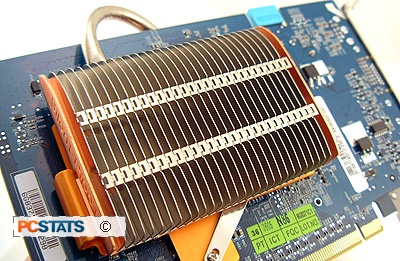The large passive heatpipe cooler on the Gigabyte GV-NX76T256D-RH videocard is dubbed
the Silent-Pipe II. It is a dual slot solution, and will definitely
take up the expansion slot directly beneath the videocard. Depending on the
motherboard layout (and the size of expansion cards), the radiator on top
of the videocard could also take up an additional expansion slot or interfere with
northbridge cooling solutions.

A single GeForce 7600GT GPU generates a
moderate amount of heat, and that's why manufacturers can get away with
passively cooled GPUs. The core first comes in contact with Silent-Pipe II's
copper heatspreader which helps draw the heat away quickly. The heatpipes are sandwiched between the
copper heatspreader and the large die cast copper heatsink directly above the GeForce 7600GT
GPU.
Two separate heatpipes move the heat to different places, the one
on the left moves the heat to a 20 aluminum finned radiator that will take up
the expansion slot just below the videocard. The heatpipe on the right moves heat
to the back of the videocard where there is an additional 28 finned aluminum radiator
located.

The Silent-Pipe II cooler is obviously designed to work
with system airflow, but looking at Gigabyte's diagrams, it appears that
Silent-Pipe II is designed specifically for cases
with negative pressure (more exhaust airflow than intake). Cold air is supposed
to be drawn into the case through the GV-NX76T256D-RH's radiator fins
along the PCI slot bracket, and expelled out by the power supply. The
heatsink on the rear of the videocard is cooled by exhaust air from the
adjacent CPU heatsink fan.

These two thermal images were provided by Gigabyte, but you
can clearly
see that the Silent-Pipe II cooler keeps the GeForce 7600GT core nice and
cool. Next up PCSTATS tries a little silent videocard overclocking.
